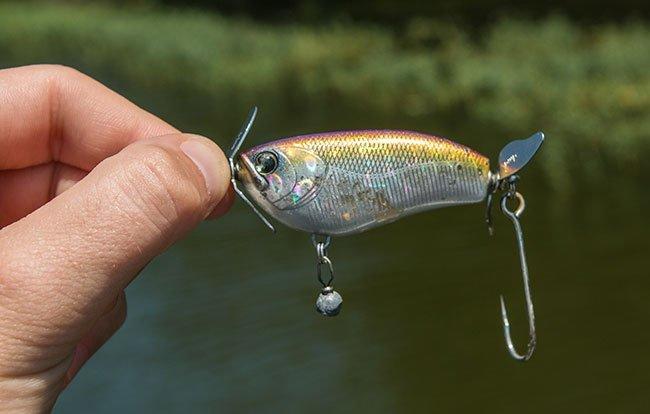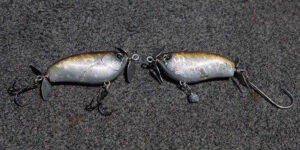With all of the topwater lures in today’s bass fishing world, it’s easy to overlook the effectiveness of prop baits. As boiling water temperatures continue to wreak havoc on bass fishing opportunities throughout the country, these oft forgotten lures can elicit violent strikes when others fall short.
According to fisheries biologist and BASS Opens pro Michael Murphy, many bass anglers are severely limiting the potential of their prop baits. Just a few simple tweaks can create an all-terrain topwater lure that can quickly cure your case of the summertime bass blues.
Bid farewell to treble hooks
Let’s be real for a minute—the fishing is downright tough for almost everyone right now. With the lower oxygen levels and lethargic nature of the bass, it’s tough to imagine a hot topwater bite. Prop baits, however, have a few characteristics that make them especially effective in tough conditions.
“I consider the prop bait to be an agitator bait,” Murphy said. “You can keep it in the strike zone for a long time and it creates a lot of commotion, forcing bass to attack it even when they’re not looking to feed. Whenever you’re target casting to specific cover, it’s incredibly tough to beat.”
That sounds fine and dandy, but how in the world do you avoid getting the treble hooks snagged in thick cover? Murphy has found the answer and I must admit—it’s pretty cool.
“When many people find bass in heavy cover, they tend to reach for a topwater frog,” Murphy said. “It can certainly work sometimes, but it’s often too subtle for these lazy fish. This is why I’ve started to modify my prop baits. It allows me to dissect the thick stuff with a noisy topwater presentation and avoid constant hang-ups.”
There are two modifications he makes to his Ima Helips Prop Bait. Interestingly enough, it involves a drop shot weight and a spinnerbait trailer hook.
- Drop shot weight—”I like to remove the front hook and replace it with a 1/32 or 1/16-ounce lead drop shot weight,” Murphy said. “The prop bait needs to be completely level so both props can catch water, which makes it important to add a small drop shot weight. Using lead enables me to precisely trim the weight to ensure a perfect balance in every situation.”
- Trailer hook—”If you’re fishing around thick cover, the back treble hook of any prop bait is bound to get snagged,” Murphy said. “To avoid this, I replace the back treble hook with a 3/0 or 4/0 spinnerbait trailer hook. It drastically expands your heavy cover options and the longer shank helps turn short strikes into well-hooked fish. I’ve actually enjoyed a very high hookup ratio with this setup, too. Once you hook ’em, they’re coming in the boat.”
Put it where they live
While Murphy tends to rely on buzzbaits and topwater poppers when quickly searching for a shallow topwater pattern, he uses a prop bait to more thoroughly saturate high-percentage areas.
“If I go through a 20-yard stretch of bank and have a few bass miss my buzzbait, I’m going to turn around and dissect the area with a prop bait,” Murphy said. “It moves much slower and when those props are spinning right on top of the bass, they have a very difficult time not eating it. In other words, when I’m in ‘search and destroy’ mode, the modified prop bait is definitely my ‘destroy’ bait. I can throw it into some of the nastiest stuff on the lake without any problems.”
Because these late-summer bass aren’t known for swimming great distances to attack lures, it’s important to target very specific areas with your modified prop bait.
- Isolated shade—”Bass are in the same proverbial boat with us right now,” Murphy said. “They’re hot and looking for shade, which makes isolated shade an excellent target for prop bait fishing. These small patches concentrate nearby bass and make their likely locations very easy to pinpoint. Instead of fishing a whole stretch of sunny bank, you can quickly cover water this way while increasing your odds of getting bit.”
- Bluegill beds—”It’s hard to find a better bluegill imitator than a prop bait,” Murphy said. “But it can be difficult to fish these super-shallow areas with treble hooks. This modified version, however, will allow you to fish in the middle of grass beds, behind grass beds and around very shallow laydowns—everywhere bluegill beds are likely to be.”
- Mayfly hatches—”If your area has had some rainfall in the past few days, take some time to look for mayfly hatches on your favorite fishery,” Murphy said. “Look for black, overhanging bushes, crows very near the water or of course, swarms of mayflies. Fire this modified prop bait into these areas and hang on.”
- Flats near steep banks—”You’ll be able to catch a lot of big migrant bass by looking for flats near steep banks this time of year,” Murphy said. “Work the prop bait around any isolated cover on these flats because when the bass are on these flats, they’re there for one reason—to feed. So the can be very easy to catch.”
Subtle and aggressive retrieve methods
Effectively presenting your modified prop bait can take a bit of patience, but the bites will make the wait totally worth it. More often than not, your goal should be to make as much noise as possible while minimizing the distance the bait moves.
Throughout his experience, Murphy has had his most consistent success using two primary retrieves.
- Pop-and-stop—”I’m going to fish my modified prop bait like a topwater popper most of the time,” Murphy said. “If it’s balanced correctly, short, downward twitches of the rod tip can make a modified Ima Helips walk on the surface while making a ton of noise. You will, however, have to experiment with the length of your pauses and your cadence. The bass’ preference can change daily right now, so always keep an open mind.”
- Rip it—”If you’re fishing bluegill beds, ripping the prop bait can be deadly,” Murphy said. “The bass are looking for the one bream that makes the sudden move. They don’t really mess with the inactive bream, so try to rip your modified prop bait so it leaves a 12 to 18-inch bubble trail. It’s a great way to get some of those bigger bites.”
Simplify your color selection
If you spend some time browsing Tackle Warehouse, you’re going to see enough prop bait colors to make your head hurt. Before you get overwhelmed, however, consider Murphy’s simple two-step color selection process.
- What are you fishing?—”If I’m fishing main lake cover and structure such as points, seawalls and boat docks, I’ll usually choose some sort of shad-colored prop bait,” Murphy said. “When I start making my way back into creeks, however, I’ll start using more bluegill patterns because the further back you go right now, the more bluegill you’ll find.”
- What’s the sky look like?—”Translucent, foil-based finishes are extremely effective in sunny conditions,” Murphy said. “They look much more natural to the bass and they put off a lot of flash when as you work the prop bait. If it’s cloudy, try to stick with matte color schemes. These colors create a more distinguished profile in lowlight conditions which makes them much easier for bass to locate.”
If the bass fishing is tough in your area, don’t overlook the effectiveness of prop baits. These simple modifications will help you confidently target high-percentage areas, draw strikes from otherwise lethargic fish and show the bass a unique lure that very few anglers use anymore.
https://s3media.247sports.com/Uploads/wired2fish/2014/08/modified-prop-bait.jpg















